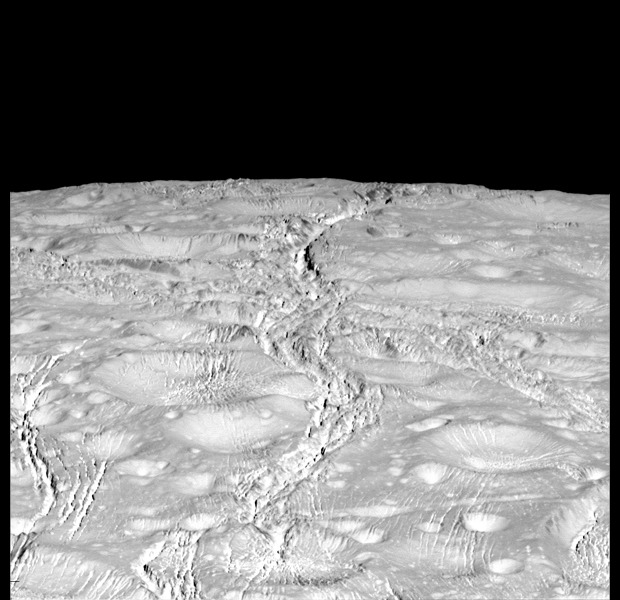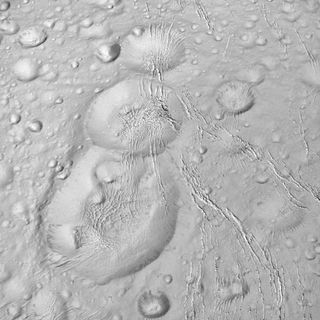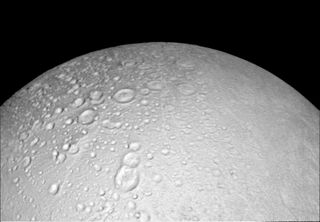
NASA's Cassini spacecraft has captured its best-ever looks at the north polar region of Saturn's ocean-harboring moon, Enceladus.
Cassini zoomed within 1,142 miles (1,838 kilometers) of Enceladus Wednesday (Oct. 14), performing its 20th close flyby of the icy satellite since arriving in the Saturn system in 2004. The spacecraft has already beamed home some of the new close-encounter images, and more will come down to Earth in the next few days, NASA officials said.
Many of Cassini's previous Enceladus flybys occurred when the moon's far northern reaches were cloaked in winter darkness. But northern summer has arrived in the Saturn system, and the recent flyby brought the mysterious region out into the light. [Photos of Enceladus, Saturn's Icy Moon]

"The northern regions are crisscrossed by a spidery network of gossamer-thin cracks that slice through the craters," Cassini imaging team member Paul Helfenstein, of Cornell University in Ithaca, New York, said in a statement. "These thin cracks are ubiquitous on Enceladus, and now we see that they extend across the northern terrains as well."
Cassini spotted powerful water-ice geysers near Enceladus' south pole in 2005. These jets are blasting into space material from the ocean of liquid water that sloshes beneath Enceladus' ice shell, scientists say.
Mission scientists will scan the new flyby images for signs of activity coming from the north polar region as well, NASA officials said.
Wednesday's flyby serves as a prelude to another upcoming close encounter: On Oct. 28, Cassini will cruise within just 30 miles (49 km) of Enceladus' south polar region, NASA officials said.
Get the Space.com Newsletter
Breaking space news, the latest updates on rocket launches, skywatching events and more!
"During the encounter, Cassini will make its deepest-ever dive through the moon's plume of icy spray, sampling the chemistry of the extraterrestrial ocean beneath the ice," agency officials wrote in the same statement.
"Mission scientists are hopeful data from that flyby will provide evidence of how much hydrothermal activity is occurring in the moon's ocean, along with more detailed insights about the ocean's chemistry —both of which relate to the potential habitability of Enceladus," they added.

Cassini will fly by Enceladus again on Dec. 19, approaching within 3,106 miles (4,999 km) of the satellite and gathering data that should help scientists gauge how much heat is coming from the satellite's interior. (That heat is generated by friction, which itself is primarily the result of Saturn's powerful gravitational pull, researchers say.)
Those two future flybys will be Cassini's last close encounters with the 314-mile-wide (505 km) Enceladus. Cassini will end its $3.2 billion mission — which is a collaboration involving NASA, the European Space Agency and the Italian Space Agency — with an intentional death dive into Saturn's thick atmosphere in September 2017.
You can see more Enceladus images from Wednesday's flyby here: http://saturn.jpl.nasa.gov/mission/flybys/enceladus20151014/
Follow Mike Wall on Twitter @michaeldwall and Google+. Follow us @Spacedotcom, Facebook or Google+. Originally published on Space.com.
Join our Space Forums to keep talking space on the latest missions, night sky and more! And if you have a news tip, correction or comment, let us know at: community@space.com.

Michael Wall is a Senior Space Writer with Space.com and joined the team in 2010. He primarily covers exoplanets, spaceflight and military space, but has been known to dabble in the space art beat. His book about the search for alien life, "Out There," was published on Nov. 13, 2018. Before becoming a science writer, Michael worked as a herpetologist and wildlife biologist. He has a Ph.D. in evolutionary biology from the University of Sydney, Australia, a bachelor's degree from the University of Arizona, and a graduate certificate in science writing from the University of California, Santa Cruz. To find out what his latest project is, you can follow Michael on Twitter.











